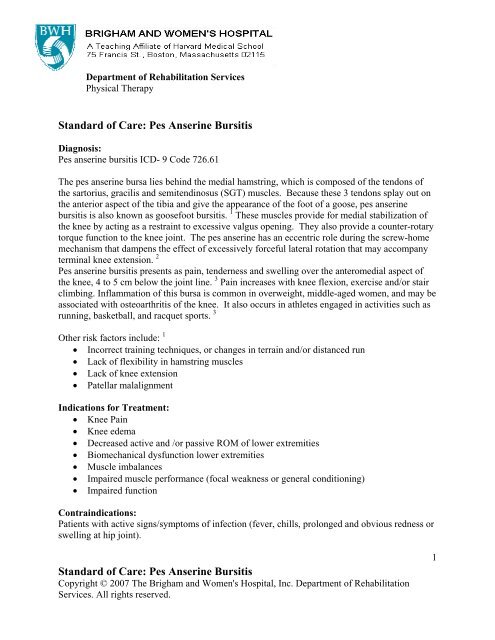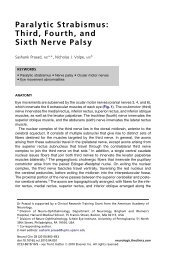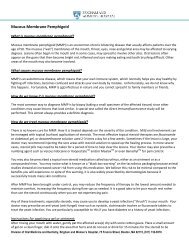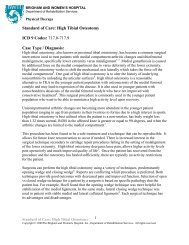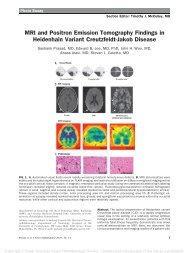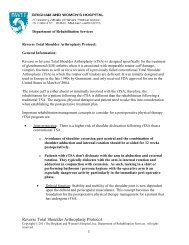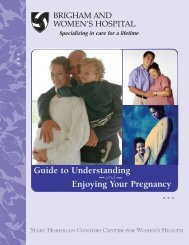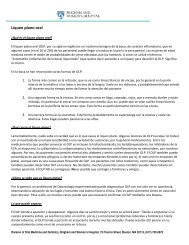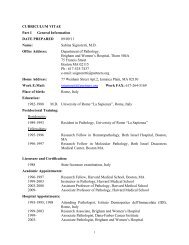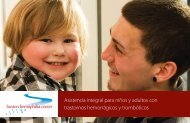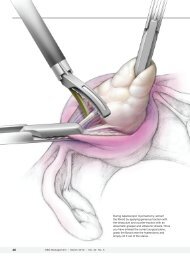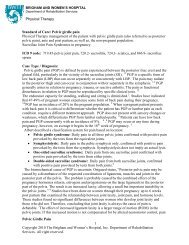Pes Anserine Bursitis - Brigham and Women's Hospital
Pes Anserine Bursitis - Brigham and Women's Hospital
Pes Anserine Bursitis - Brigham and Women's Hospital
You also want an ePaper? Increase the reach of your titles
YUMPU automatically turns print PDFs into web optimized ePapers that Google loves.
Department of Rehabilitation Services<br />
Physical Therapy<br />
St<strong>and</strong>ard of Care: <strong>Pes</strong> <strong>Anserine</strong> <strong>Bursitis</strong><br />
Diagnosis:<br />
<strong>Pes</strong> anserine bursitis ICD- 9 Code 726.61<br />
The pes anserine bursa lies behind the medial hamstring, which is composed of the tendons of<br />
the sartorius, gracilis <strong>and</strong> semitendinosus (SGT) muscles. Because these 3 tendons splay out on<br />
the anterior aspect of the tibia <strong>and</strong> give the appearance of the foot of a goose, pes anserine<br />
bursitis is also known as goosefoot bursitis. 1 These muscles provide for medial stabilization of<br />
the knee by acting as a restraint to excessive valgus opening. They also provide a counter-rotary<br />
torque function to the knee joint. The pes anserine has an eccentric role during the screw-home<br />
mechanism that dampens the effect of excessively forceful lateral rotation that may accompany<br />
terminal knee extension. 2<br />
<strong>Pes</strong> anserine bursitis presents as pain, tenderness <strong>and</strong> swelling over the anteromedial aspect of<br />
the knee, 4 to 5 cm below the joint line. 3 Pain increases with knee flexion, exercise <strong>and</strong>/or stair<br />
climbing. Inflammation of this bursa is common in overweight, middle-aged women, <strong>and</strong> may be<br />
associated with osteoarthritis of the knee. It also occurs in athletes engaged in activities such as<br />
running, basketball, <strong>and</strong> racquet sports. 3<br />
Other risk factors include: 1<br />
• Incorrect training techniques, or changes in terrain <strong>and</strong>/or distanced run<br />
• Lack of flexibility in hamstring muscles<br />
• Lack of knee extension<br />
• Patellar malalignment<br />
Indications for Treatment:<br />
• Knee Pain<br />
• Knee edema<br />
• Decreased active <strong>and</strong> /or passive ROM of lower extremities<br />
• Biomechanical dysfunction lower extremities<br />
• Muscle imbalances<br />
• Impaired muscle performance (focal weakness or general conditioning)<br />
• Impaired function<br />
Contraindications:<br />
Patients with active signs/symptoms of infection (fever, chills, prolonged <strong>and</strong> obvious redness or<br />
swelling at hip joint).<br />
St<strong>and</strong>ard of Care: <strong>Pes</strong> <strong>Anserine</strong> <strong>Bursitis</strong><br />
Copyright © 2007 The <strong>Brigham</strong> <strong>and</strong> <strong>Women's</strong> <strong>Hospital</strong>, Inc. Department of Rehabilitation<br />
Services. All rights reserved.<br />
1
Precautions for Treatment:<br />
• OA-presence of osteophytes must be taken into account when establishing goals<br />
<strong>and</strong> treatment plan<br />
• RA-patient may be at greater risk of infection; cyst formation may appear on<br />
radiograph, <strong>and</strong> the cyst may communicate with bursa<br />
• DM-increased risk of infection<br />
• Refer to modality practice st<strong>and</strong>ards for other contraindications <strong>and</strong> precautions<br />
Examination:<br />
Past Medical History:<br />
• Previous repetitive strain/overuse injuries involving lower extremities<br />
• Trauma to lower extremities<br />
• Systemic disease process (eg. RA, DM, connective tissue disorders)<br />
• Osteoarthritis<br />
History of Present Illness:<br />
• Location of pain <strong>and</strong> pain level<br />
• Inciting events or precipitating activities<br />
• Signs/symptoms of infection<br />
• Symptom modifiers (medications, rest, ice)<br />
• Functional limitations<br />
Social History:<br />
• Nature of work-especially noting if patient is at risk due to faulty lower extremity<br />
biomechanics or postural strain (prolonged st<strong>and</strong>ing)<br />
• Recreational activities-type, frequency/duration, terrain, footwear<br />
• Home environment-stairs, ADL’s<br />
• Support system-motivation, ability to follow up with recommendations <strong>and</strong><br />
physical therapy plan of care<br />
Medications:<br />
• NSAIDS, injection of corticosteroid into bursa<br />
Test results: Review results of any recent lower extremity imaging (radiographs, CT<br />
scan, MRI). Prevalence of 2.5% on MRI in symptomatic adults. 4<br />
Physical Examination:<br />
This section is intended to capture the minimum data set <strong>and</strong> identify specific circumstance(s) that might<br />
require additional tests <strong>and</strong> measures.<br />
St<strong>and</strong>ard of Care: <strong>Pes</strong> <strong>Anserine</strong> <strong>Bursitis</strong><br />
Copyright © 2007 The <strong>Brigham</strong> <strong>and</strong> <strong>Women's</strong> <strong>Hospital</strong>, Inc. Department of Rehabilitation<br />
Services. All rights reserved.<br />
2
• Pain: typical presentation is pain localized to the anteromedial aspect of the knee,<br />
4 to 5 cm below the joint line, often exacerbated by knee flexion. 3<br />
• Palpation: tenderness over the affected bursa, with swelling, erythema <strong>and</strong><br />
warmth<br />
•<br />
• Lower quarter screen:<br />
-Active <strong>and</strong> passive ROM of hip, knee <strong>and</strong> ankle joints, joint play<br />
-Patellar mobility <strong>and</strong> tracking<br />
-lower extremity manual muscle testing (if condition is chronic, the<br />
affected limb may show disuse atrophy <strong>and</strong> weakness)<br />
• Tests:<br />
-Thomas test, hamstring flexibility, leg length measurement, McMurray’s,<br />
ligamentous stability tests, Faber <strong>and</strong> Scour tests<br />
• Posture:<br />
Note hip posture: IR/ER of hip<br />
Note knee posture: varus/valgus, hyperextension, flexion contracture<br />
Note foot posture: pes planus/cavus, hallux valgus<br />
Note if any weight-bearing avoidance or intolerance on affected extremity<br />
• Gait:<br />
-Analysis gait during stance <strong>and</strong> swing phases of cycle<br />
-Stride length<br />
-Dynamic st<strong>and</strong>ing balance<br />
-Stair climbing<br />
-Assistive devices<br />
-Footwear<br />
• Sensation<br />
• Lower extremity functional scale (LEFS)<br />
Differential Diagnosis: 3,4<br />
• Stress fracture<br />
• Degenerative joint disease<br />
• Meniscal injury<br />
• Collateral ligament injury<br />
• Atypical medial meniscal cysts<br />
• Juxtarticular bone cysts<br />
• Semimembranosus bursitis<br />
• Tibial collateral ligament bursitis<br />
• Saphenous nerve entrapment 5<br />
St<strong>and</strong>ard of Care: <strong>Pes</strong> <strong>Anserine</strong> <strong>Bursitis</strong><br />
Copyright © 2007 The <strong>Brigham</strong> <strong>and</strong> <strong>Women's</strong> <strong>Hospital</strong>, Inc. Department of Rehabilitation<br />
Services. All rights reserved.<br />
3
Assessment:<br />
Problem List: likely to include but not limited to:<br />
• Pain<br />
• Decreased ROM<br />
• Decreased muscle strength<br />
• Gait deviations<br />
• Decreased function<br />
• Postural dysfunction/impaired lower extremity biomechanics<br />
• Knowledge deficit: condition, self-management, home program,<br />
prevention<br />
Prognosis: Good to excellent with compliance to prescribed medical <strong>and</strong> rehabilitation<br />
management<br />
Goals:<br />
1) Decreased pain<br />
2) Increased ROM<br />
3) Increased muscle strength<br />
4) Improved gait quality <strong>and</strong> efficiency<br />
5) Maximize return to pre-injury activities<br />
6) Improved lower extremity biomechanics<br />
7) Independent self-management of symptoms; independence with home<br />
exercise program; independence with prevention of re-injury/re-occurrence<br />
Age Specific Considerations: <strong>Pes</strong> anserine bursitis can occur at any age, but is common<br />
in middle-aged women with knee osteoarthritis. 3 Individuals with associated<br />
comorbidities will require more careful goal setting <strong>and</strong> treatment planning which<br />
consider specific factors that maybe influencing the complete recovery of function.<br />
Treatment Planning / Interventions:<br />
Established Pathway ___ Yes, see attached. _X__ No<br />
Established Protocol ___ Yes, see attached. __X_ No<br />
Interventions most commonly used for this case type/diagnosis:<br />
1. NSAIDs<br />
2. Corticosteriod injection<br />
3. Therapeutic exercises to increase lower extremity muscle strength <strong>and</strong><br />
flexibility, to decrease friction on the bursa <strong>and</strong> improve joint mechanics<br />
St<strong>and</strong>ard of Care: <strong>Pes</strong> <strong>Anserine</strong> <strong>Bursitis</strong><br />
Copyright © 2007 The <strong>Brigham</strong> <strong>and</strong> <strong>Women's</strong> <strong>Hospital</strong>, Inc. Department of Rehabilitation<br />
Services. All rights reserved.<br />
4
4. Modalities such as ice, ultrasound <strong>and</strong> high-voltage electrical stimulation to<br />
decrease inflammation <strong>and</strong> pain<br />
5. Gait training for efficient <strong>and</strong> effective pattern (consider DME as appropriate)<br />
6. Orthotic consultation<br />
7. Instruction in home exercise program<br />
Frequency & Duration: 1-2x/week for 4-6 weeks<br />
Patient / family education:<br />
1. Home exercise program<br />
2. Sports specific training<br />
3. Pain <strong>and</strong> edema management<br />
Recommendations <strong>and</strong> referrals to other providers:<br />
1. Orthopedist<br />
2. Orthotist<br />
3. Rheumatologist<br />
4. Physiatrist<br />
5. PCP<br />
Re-evaluation / assessment<br />
Time Frame: every 30 days <strong>and</strong>/or prior to visit with physician<br />
Other Possible Triggers for re-evaluation are:<br />
1. Significant change in the signs <strong>and</strong> symptoms, fall or acute trauma<br />
2. Failure to progress per established short-term goals<br />
3. Complications or worsening of associated conditions<br />
Discharge Planning<br />
Commonly expected outcomes at discharge:<br />
1. Resolution of pain<br />
2. Increased AROM <strong>and</strong> strength<br />
3. Increased lower extremity muscle flexibility<br />
4. Return to pre-injury function <strong>and</strong> sports activities<br />
Patient’s discharge instructions:<br />
1. Progressed home exercise program<br />
2. Sports specific training<br />
3. Injury prevention<br />
St<strong>and</strong>ard of Care: <strong>Pes</strong> <strong>Anserine</strong> <strong>Bursitis</strong><br />
Copyright © 2007 The <strong>Brigham</strong> <strong>and</strong> <strong>Women's</strong> <strong>Hospital</strong>, Inc. Department of Rehabilitation<br />
Services. All rights reserved.<br />
5
Bibliography / Reference List<br />
1. American Academy of Orthopaedic Surgeons. Goosefoot (<strong>Pes</strong> <strong>Anserine</strong>) <strong>Bursitis</strong> of the Knee.<br />
Available at: www.aaos.org. Accessed May 15, 2000.<br />
2. Saidoff DC, McDonough AL. Knee <strong>and</strong> shin. In: Critical Pathways in Therapeutic<br />
Intervention. Extremities <strong>and</strong> Spine. 1st ed. St. Louis: Mosby; 2002:546.<br />
3. Butcher JD, Salzman KL, Lillegard WA. Lower extremity bursitis. Am Fam Physician.<br />
1996;53:2317-2324.<br />
4. Rennie WJ, Saifuddin A. <strong>Pes</strong> anserine bursitis: Incidence in symptomatic knees <strong>and</strong> clinical<br />
presentation. Skeletal Radiol. 2005;34:395-398.<br />
5. Hemler DE, Ward WK, Karstetter KW, Bryant PM. Saphenous nerve entrapment caused by<br />
pes anserine bursitis mimicking stress fracture of the tibia. Arch Phys Med Rehabil.<br />
1991;72:336-337.<br />
Developed by: Reviewed by: Sharon Alzner, PT 1/06<br />
Marie-Josee Paris, PT 12/05 Ethan Jerome, PT 1/06<br />
Joan Casby, PT 2/06<br />
St<strong>and</strong>ard of Care: <strong>Pes</strong> <strong>Anserine</strong> <strong>Bursitis</strong><br />
Copyright © 2007 The <strong>Brigham</strong> <strong>and</strong> <strong>Women's</strong> <strong>Hospital</strong>, Inc. Department of Rehabilitation<br />
Services. All rights reserved.<br />
6


